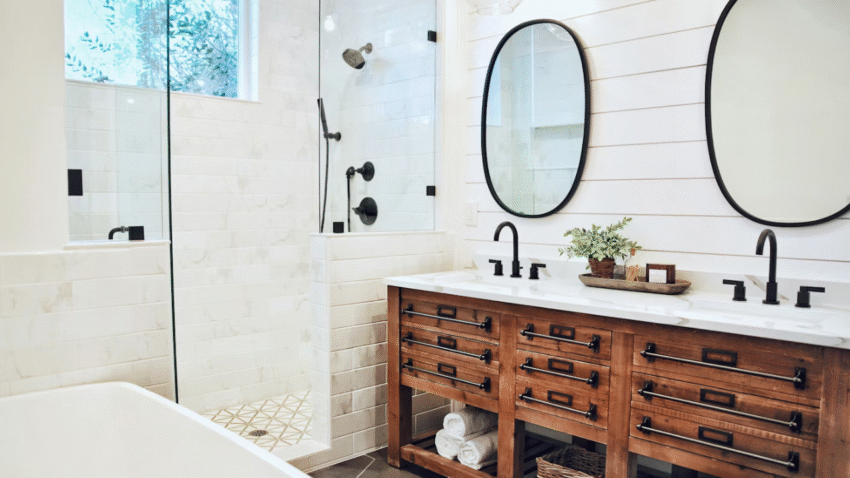Introduction
Is the caulk in your bathroom cracking, discolored, or peeling away from surfaces? This guide will show you exactly how to remove old caulking in the bathroom safely and efficiently. Caulking that’s past its prime can invite mold, mildew, and leaks—making your bathroom look and feel neglected. Thankfully, removing it is a task you can tackle with a bit of patience and the right tools.
Why Removing Old Caulking Matters in the Bathroom
Old caulking doesn’t just look bad—it can seriously compromise your bathroom’s hygiene and structure. When the caulk around your tub, shower, or sink starts to degrade, it creates tiny gaps where water can seep in. This leads to mold growth, damage to drywall or flooring, and even structural decay over time.
Removing the old caulk is essential before applying fresh sealant. Doing so ensures better adhesion, prevents leaks, and gives your bathroom a cleaner, more finished appearance. Plus, it helps you maintain a moisture barrier in key areas like tile joints, countertops, and plumbing fixtures.
Step-by-Step Guide to Removing Old Caulking
1. Gather Your Tools
Before you start, make sure you have everything you need:
- Utility knife or caulk remover tool
- Plastic putty knife or scraper
- Needle-nose pliers (optional)
- Rubbing alcohol or white vinegar
- Clean rags or paper towels
- Protective gloves
- Safety goggles (if using a caulk remover chemical)
- Painter’s tape (optional)
- Bathroom fan or open window for ventilation
2. Soften the Old Caulk
If the caulk is particularly hard or brittle, soften it before removal:
- Use a commercial caulk remover gel or spray.
- Let it sit according to product instructions—usually 10 to 20 minutes.
- Alternatively, run a hairdryer on a warm setting over the caulk for a few minutes to loosen it.
Tip: Make sure to ventilate the room well if using chemical removers.
3. Cut Along the Edges of the Caulk
Use your utility knife to slice along both sides of the old caulk line:
- Cut slowly and carefully to avoid scratching tiles or fixtures.
- Keep the blade at a shallow angle for better control.
Warning: Always cut away from your body to prevent injury.
4. Pull Away the Old Caulk
Once you’ve scored the edges:
- Use your hands or needle-nose pliers to peel the caulk away.
- Grab one end and gently pull in long strips if possible.
- For stubborn areas, scrape with a plastic putty knife or caulk tool.
5. Clean the Surface
After removing the bulk of the caulk:
- Use a rag soaked in rubbing alcohol or white vinegar to scrub the remaining residue.
- Wipe thoroughly to remove grease, dust, or mold.
- Let the area dry completely before applying new caulk.
Tip: For moldy surfaces, use a bleach-and-water solution (1 part bleach to 10 parts water) and let dry thoroughly.
Common Mistakes to Avoid
Mistake 1: Using metal tools to scrape caulk
Solution: Use plastic tools to avoid scratching tiles or damaging tubs and sinks.
Mistake 2: Leaving behind small bits of old caulk
Solution: Always clean residue with rubbing alcohol or a scrubbing pad to ensure proper adhesion of new caulk.
Mistake 3: Not allowing the area to dry
Solution: Moisture can ruin your new sealant. Wait at least a few hours—ideally overnight—before recaulking.
Mistake 4: Pulling too aggressively
Solution: Tug gently and patiently. Forcing it may chip surfaces or rip away grout.
Mistake 5: Skipping ventilation
Solution: Open a window or run your bathroom fan—especially if you’re using chemical caulk removers.
Extra Tips & Bathroom Hacks
- Use painter’s tape along the tile edge to keep your cutting lines straight and protect adjacent surfaces.
- Try a caulk removal tool set—these often include both a cutter and a scraper designed for this exact task.
- Check out our guide on how to apply new bathroom caulking after you’ve removed the old one for a seamless, waterproof seal.
Conclusion
Removing old caulking in the bathroom might seem tedious, but it’s an essential maintenance task that protects your bathroom from water damage and keeps it looking fresh. With the right tools and careful technique, you can strip away the old material without damaging tiles or fixtures. Just remember to soften the caulk, cut slowly, pull gently, and clean thoroughly before moving on to re-caulking.
💡 Bookmark this guide so you can keep your bathroom fresh, clean, and problem-free all year round.
